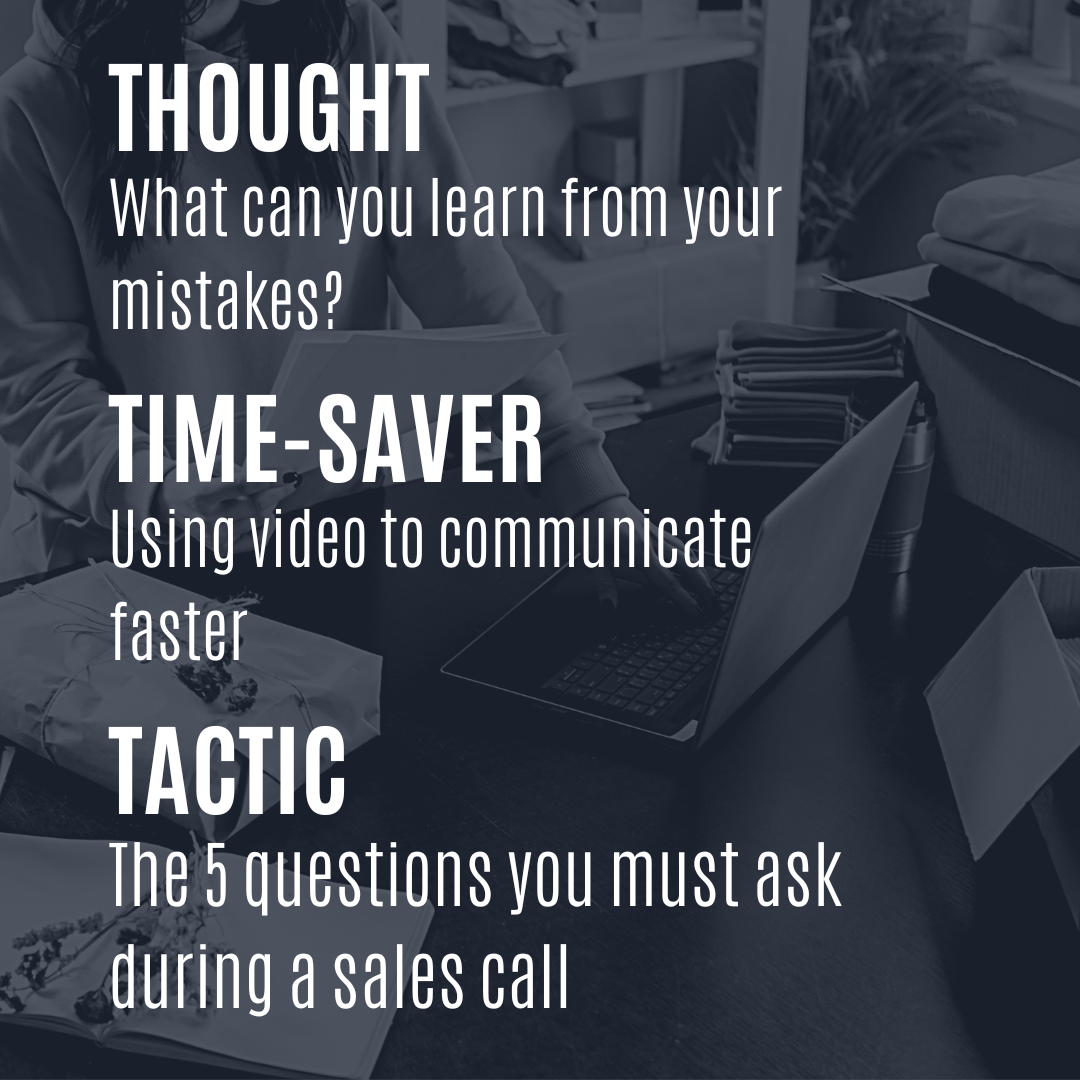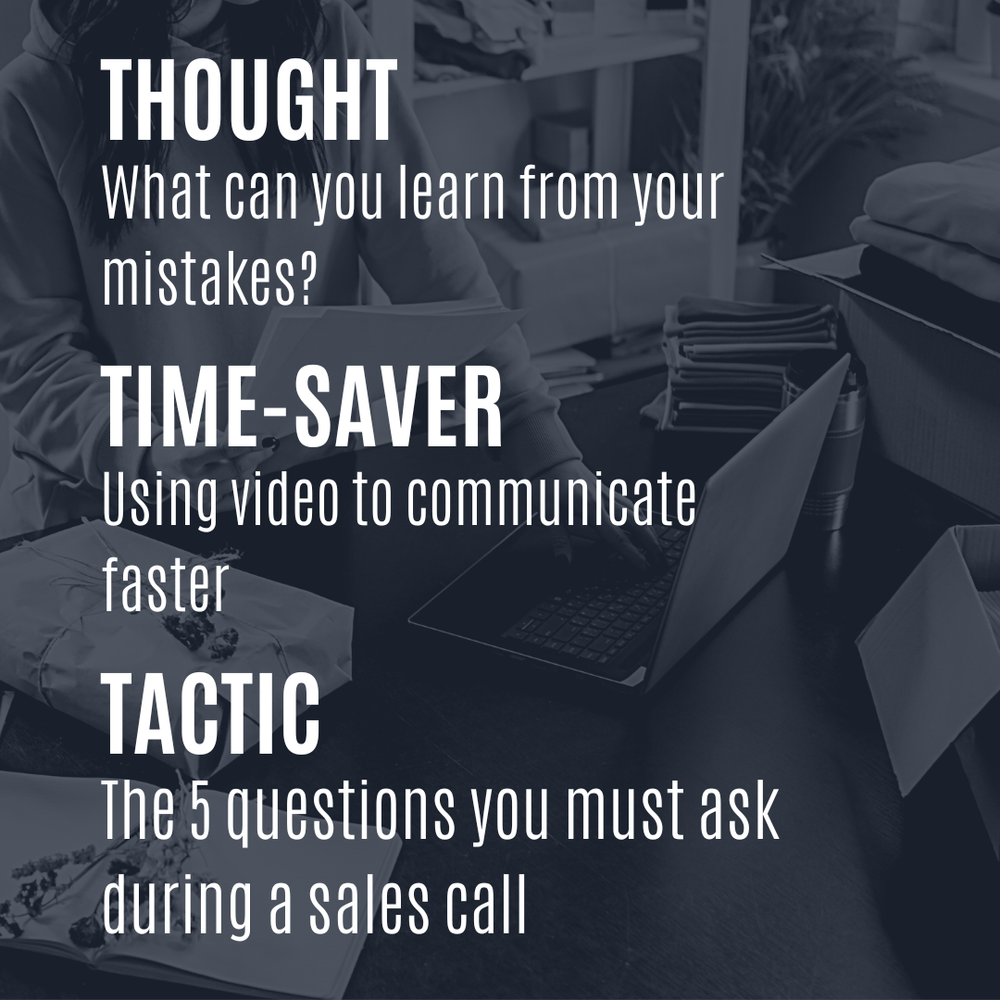Want to receive The Solopreneur’s Shortcut every week? Subscribe here. We’ll send one thought, one tactic, and one time saver straight to your inbox. No fluff, just proven techniques for growing your business.

I’ll start by quickly sharing a message I received on LinkedIn this week and then explain how it relates to you.
“Hi Terry, Recently I moved into Qatar and started a IT solution and services company. Currently I’m in a very bad shape and completely out of my mind. When I was looking for a way for me to recover, I found you. Thank you for sharing the post with guidance”
It’s hard to describe how much I appreciate these messages and I want to say thanks again to everyone who has replied to this newsletter or sent me a note on LinkedIn. I know your time is valuable, and I’m grateful for the feedback and support.
And now, let’s get started.
Thought: What can you learn from your mistakes?
Time-saver: Using video to communicate faster
Tactic: The 5 questions you must ask during a sales call
Read time: 5 minutes
Thought: What can you learn from your mistakes?
Sending a proposal to a prospective client can be a nerve racking experience. What happens if you make a mistake?
I recently chatted with an acquaintance who told me about a time when she was working on a proposal way too late at night. She was so tired she misquoted her hourly rate. Instead of saying she charged $50/hr, she accidentally said $500/hr.
The next day the prospect got back to her and said “Look we can’t pay you $500/hr, but we can pay you $300/hr, how does that sound?” Well, it sounds to me like she just 6X’d her revenue because of a mistake. And as a result she learned to charge much more going forward.
Admittedly, this is a very obvious example of how you can learn from your mistakes. In many situations you’ll have to dig much deeper to find the lesson.
Here’s one of mine.
A few months ago I was on a sales call and completely botched the process.
(Fortunately, I’ll explain how you can avoid that during this week’s tactic)
I was chatting with a prospect and I got so into it that I started solving all her problems during the call. At the end she said “This was amazing. I really wanted to work with you but I feel like I got all the information I needed already. I’m going to implement what you told me then follow up later.”
As you may have guessed, I haven’t heard back from her. And it’s important to note she wasn’t just looking for free advice, she would have happily paid for my services. I just messed up talking too much.
So here’s a thought for today.
What can you learn from a mistake you’ve made recently, or in the past?
Remember, failure is data, and we can use that information to improve ourselves going forward.
Time-saver: Using video to communicate faster
My virtual assistant, Megan, handles everything from booking appointments to editing videos, even finding local camps for my kids. Outside of the services she provides, she also proactively sends over good ideas to grow my business and challenges some of my bad ones.
There’s only one way things can go wrong; miscommunication.
I’m often on the move or in a hurry so my emails and messages may not be as clear as I’d like them to be. So if she – rightfully – misinterprets what I’m saying; that’s completely my fault.
How do I avoid this problem? Send video messages instead.
I use a program called Loom, a video messaging tool that helps you get your point across through shareable videos.
With Loom you can record your camera, microphone, and desktop simultaneously. Your video is then instantly available to share through a unique URL.
This makes it way easier for me to communicate with Megan because I can quickly share and show more details.
For example, I recently ran into an issue where some text on my website was hidden. Instead of badly explaining this through email or messaging, I just made a video showing her exactly what the problem was and asking her to address it.
She understood exactly what I meant and my website was updated within an hour.
Here’s a real example of me using Loom to delegate a task. The video is only two minutes long and I strongly suggest using the tactic I referenced.
I’ve used the same tool to quickly communicate with clients as well.
The use cases vary but here are a few so you can wrap your head around it:
- Pointing out issues with the contact form on their website
- Explaining how to make a template in Canva
- A quick pep talk before a big meeting
The videos have also helped me pitch and win clients as well.
When sending out a proposal I’ll sometimes include a quick video of me talking through it at a high level and reiterating why I’d like to partner with the prospect.
This is incredibly beneficial when multiple people – some of whom you haven’t met – are involved in the decision making process.
As a bonus, you’ll also know when and how many people have watched your video.
You can use Loom for free so give it a try and let me know what you think.
Tactic: The 5 questions you must ask during a sales call
I spend a great deal of time building my personal brand. It’s a great way to attract prospects who already know, like and trust you before you even meet.
Another benefit? It makes sales calls way easier!
I still don’t enjoy sales calls – I’d rather just help people – but I’ve discovered a process that makes the experience much more enjoyable and leads to a higher rate of closed deals.
So now let’s walk through the five questions you must ask during a sales call so you can win more deals and charge your true value.
Question 1
“What’s going on and how is it affecting your business/personal life?”
This question will help you avoid a very common mistake; talking about yourself too much.
Sure, you have a lot to share, but you have no idea what to talk about until you get a deeper understanding of their challenges.
Listen closely and avoid the urge to interrupt or immediately start solving their problems. If possible, ask a follow up question or take a shot at inferring the impact of these challenges.
So for example if a client said to me “I’m unclear on how to document the services I provide on my website.” I could follow up and say “Ok, I get it. Does that also have a negative impact on your ability to ask for referrals?”
You don’t even have to be right, you just need to demonstrate that you’re listening and you’re thinking from their perspective.
Question 2
“What have you already tried to resolve this situation?”
Their response will help you in two ways:
- You won’t repeat the same process, unless you can make it work this time.
- You’ll understand how important the problem is based on the amount of time, money and resources they’ve already invested.
You can also adjust your rates based on their response.
One time a prospect told me they already invested $50k in a solution that didn’t work so I knew they wouldn’t be shocked if I charged a similar amount.
Again, this may be a good time to ask a follow up question but you should also be keeping an eye on the clock. Make sure you’ll still have time to pitch and field questions.
Question 3
“What would need to happen in order for you to feel good about our results?”
This question is super important because it’s your chance to get a clear understanding of the outcomes they’re looking for.
Typically, one of three things will happen:
Scenario 1
You’ll discover they have no idea what a successful outcome would involve or how to measure success.
In this case you could try to educate them around what they should aim for and how to measure it. But be very thoughtful if you choose this route.
Reason being, if they weren’t initially clear on what they wanted, they may not be as committed to your idea.
In situations like this I tend to walk away unless I’m fully confident about the outcomes they should be looking for and my ability to deliver measurable results.
Scenario 2
They explain exactly what they’re looking for and you discover it’s not something you can help with for one reason or another.
You can either explain what you can help them with – maybe it’s providing a strategy instead of actually doing the work – or just choose to walkway.
Scenario 3
They explain exactly what they’re looking for and you discover it’s something you can help with.
Great, now you can move on to the next question!
Question 4
“Would you like to hear how I can help?”
This is clearly a redundant question but it’s important. This is how you get their permission to pitch your services.
From there you walk through your process or solution as it applies to their specific problem. Of course, you should expect some follow up questions and you may have a few as well.
If things are still looking good you can move on to the closing question.
Question 5
“What would stop you from saying yes today?”
Getting this question answered during the conversation will save you a great deal of time, frustration and confusion.
You won’t go back and forth via email for weeks answering ad hoc questions. Or, even worse, wonder if you’ve been ghosted or not.
If they have any objections, listen closely and determine how to best address them. Maybe it’s not a good fit, maybe they just need more clarification.
Either way you’re much more likely to get a direct yes or no on the call as opposed to wondering if the deal is going to close or not.
Quick side note: I have an entire section in my video course, The Solopreneur’s Fast Track, that provides more details on how to successfully navigate these calls. You’ll also get templates for proposals and contracts to make the entire process predictable and painless.
I hope you found this valuable (please let me know) and if you did please consider sharing it with a friend. They can sign up here.
Have a great weekend!
Whenever you’re ready, there are 4 ways I can help you:
1. Learn how to start a professional service business using the skills you already have (Available now)
2. Get quick answers to your most pressing questions (booked out one week)
3. Work with me 1:1 to build your revenue and personal brand (booked out three weeks)
4. Build your professional service business with me in a cohort-based live accelerator (click to view upcoming dates)


